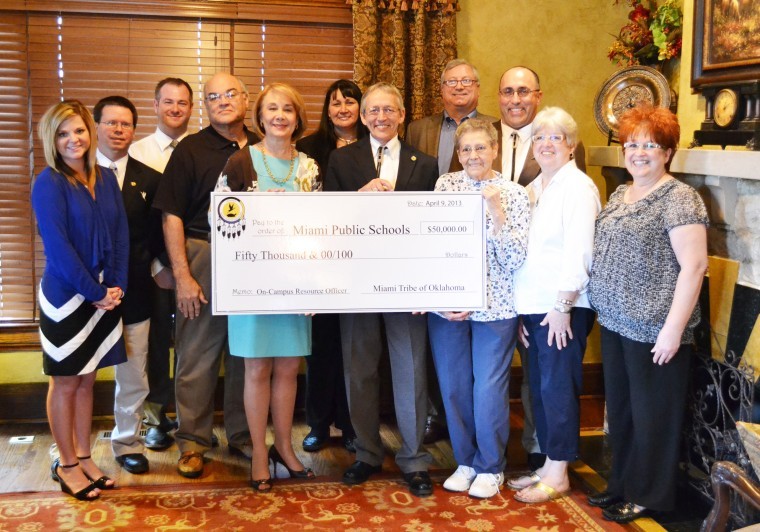“Established in 1987, the Chickasaw Nation Hall of Fame honors Chickasaws who have made significant contributions to Chickasaw people or the Native American community.”
Date: April 12, 2013 Dana Lance dana.lance@chickasaw.net From the Chickasaw Nation Hall of Fame
NORMAN, Okla. – A protector of tribal archives, a generous philanthropist, a decorated military hero, an early tribal official and a progressive Chickasaw rancher and politician comprise the 2013 class of the Chickasaw Nation Hall of Fame.
Hall of Fame ceremonies will take place at 6:30 p.m., Tuesday, May 7 at Riverwind Showplace Theater in Norman.
Established in 1987, the Chickasaw Nation Hall of Fame honors Chickasaws who have made significant contributions to Chickasaw people or the Native American community.
The 2013 Chickasaw Hall of Fame inductees are Betty Ruth Kemp, of Norman; Colbert Latimer “Bud” Baker, of Marco Island, Fla.; Gene “Nashoba” Thompson, of Austin, Texas; Thomas Benjamin Thompson, Sr.; and Benson Pikey.
Mr. Thompson and Mr. Pikey will be inducted posthumously.
Governor Bill Anoatubby will participate in the 2013 induction ceremonies.
“It is our privilege to honor these individuals who have made significant contributions to the Chickasaw Nation and the larger community,” Gov. Anoatubby said. “Their commitment to protecting tribal history, promoting education, and serving others epitomizes the spirit and dedication of the Chickasaw people.”
Betty Ruth Kemp
Betty Ruth Kemp has dedicated her life and career to protecting and preserving ancient archives and serving as a modern day Chickasaw conduit between the Southeastern homelands and Oklahoma.
Miss Kemp was born May 5, 1930 near Tishomingo, Okla., to Raymond Herrell Kemp and Mamie Melvina Hughes. Her paternal grandparents were Joel Carr Kemp and Elizabeth Minerva Perry, and her maternal grandparents were Austin Brittie Hughes and Mamie Cravatt. Her great-grandmother was Mariah Colbert.
Miss Kemp began her career in 1952 as an extra loan librarian with the University of Texas Library. She later worked as the librarian at Dallas Public Library and lead manager for two new branches from 1956 to 1964. After receiving her master’s degree, she was appointed Director of Cherokee Regional Library, a three-county regional library with headquarters in Lafayette, Walker County, Georgia.
She led a successful campaign for passage of a bond issue to construct a new 18,000 square- foot headquarters library.
Motivated by a drive to appreciate her Chickasaw heritage and encouraged by library users and local history buffs, Miss Kemp organized the Walker County Historical and Genealogical Society during this time.
In 1974, she was appointed director of the Lee-Itawamba Library System, in Tupelo, Mississippi. During her 18-year tenure as director, the library budget increased from $50,000 to $800,000 and the staff of eight increased to 25.
The Northeast Mississippi Historical and Genealogical Society and the Friends of Lee County were both organized under her direction. She helped raise funds for the renovation of the Lee Country Library when a Chickasaw collection was established for the Helen Foster Local History Room. She retired from the directorship in March 1992.
During the 1970s Miss Kemp spoke often on Chickasaw history and Native American genealogical research to organizations in the Tupelo area. Her research and her efforts to promote the Chickasaw origins in northeast Mississippi culminated in an official invitation from Pontotoc County, Mississippi to then-Chickasaw Nation Governor Overton James to celebrate with anniversary of the singing of The Treaty of Pontotoc. She also co-wrote a grant to fund archaeology research into Chickasaw habitation in the region.
Miss Kemp has served on various boards and has been involved with many organizations including: Purcell Community Council, Secretary of Oklahoma City Senior Group, President of the American Indian Cultural Society – 2001, League of Women Voters, American Association of University Women – John J. Hart Chapter, United Daughters of the Confederacy – Hugh Quinn Chapter, Daughters of the American Colonists, and Dames of the Court of Honor.
She has held many positions in the American Library Association and remains a member today. She is a member of United Methodist Church.
Miss Kemp graduated from Norman (OK) High School. She earned a bachelor’s degree in Library Science from the University of Oklahoma in 1952, and a master’s degree from Florida State University in 1965.
Miss Kemp has lived in Norman, Okla., since 1993 and participates in many Chickasaw activities and has taught many cultural craft classes.
Gene “Nashoba” Thompson
Retired U.S. Army Col. Gene “Nashoba” Thompson has dedicated his life to serving and protecting the United States and the Chickasaw Nation.
Col. Thompson was born in 1937 in Oklahoma City to Thomas and Thelma Thompson. He is the grandson of the late Thomas Benjamin Thomson, Sr., also a 2013 Hall of Fame inductee. His aunt is the late Te Ata Thompson Fisher, a 1990 Hall of Fame inductee.
Col. Thompson joined the Oklahoma National Guard at the age of 16 and retired in 1983. He was awarded the Defense Superior Service Medal, presented to senior officers who perform “superior meritorious service in a position of significant responsibility.”
While in service, Col. Thompson obtained both bachelor’s and master’s degrees from Oklahoma State University.
He was one of 13 students to be chosen by the U.S. Department of Agriculture to attend its entomology program. With help from the USDA, he later became a faculty member through the University of Nebraska Entomology Program.
A world leader in the field of entomology, Col. Thompson served as executive director of the Armed Forces Pest Management Board. This board recommends policy, procedure and offers guidance on all matters related to pest management. He developed the first program used by the Department of Defense to protect its worldwide food and clothing stockpiles.
Following his Army retirement, Mr. Thompson conducted field studies for the Texas Department of Health.
Col. Thompson is active in the Austin, Texas area as a Chickasaw Nation ambassador and an advocate for Native American culture and history. He speaks at civic organizations, seminaries and schools throughout Texas and Oklahoma about Chickasaw beliefs and practices.
He was selected to participate in the “I Am Very Proud To Be Chickasaw” commissioned painting project completed by Chickasaw artist Mike Larsen.
The subsequent artwork and biographical sketch of his life were featured in the book “Proud to Be Chickasaw,” published in 2010.
Col. Thompson is an active member of the Chickasaw Community Council of Central Texas and resides in Austin with his wife, Vivian.
Colbert Latimer “Bud” Baker, Jr.
Born in 1924 to Colbert Latimer Baker and Martha Lois Brunt, Colbert Latimer “Bud” Baker, Jr. has distinguished himself in his profession, in military service and through outstanding contributions to the Chickasaw Nation.
A University of Oklahoma graduate, Mr. Baker exemplifies the Chickasaw entrepreneurship spirit. Among other businesses, Mr. Baker founded Chickasaw Distributors, Inc., in 1979. Officially recognized as an American Indian company, the entity specializes in tubular goods and drill pipe distributed exclusively to Shell Oil’s Gulf region. Today, the company generates more than $200 million in annual sales and continues to be family operated.
Bringing honor to the Chickasaw people, Mr. Baker served as a U.S. Navy officer during World War II and the Korean War. He served aboard the USS Los Angeles and USS Toledo. He rose to the rank of ensign and was decorated for his wartime service.
Through generous donations to the Chickasaw Foundation, Mr. Baker has helped many Chickasaw students fulfill their educational dreams and better their lives. In 2000, the Colbert “Bud” Baker Scholarship was established through the Chickasaw Foundation. Mr. Baker was honored for his philanthropy in 2003 and 2004 when he received the “Outstanding Philanthropist” award presented by the Chickasaw Nation. He is a true Chickasaw in spirit and soul.
Mr. Baker is also involved in the community. He has and continues to offer leadership and guidance to civic and business organizations. He has served as president of a number of organizations including: Dallas North Texas Rotary Club, University of Oklahoma Alumni Club, and the Car and Truck Leasing Association of Texas. He has served as executive secretary of the National Truck Leasing System Dallas Executive Association, the Sales and Marketing Executives of Dallas and Executive International. He currently is a member of numerous clubs, boards and associations in the fields of petroleum, real estate and civic duty.
Mr. Baker lives in Marco Island, Florida where he enjoys tennis, swimming, calisthenics, music and reading.
Thomas Benjamin Thompson, Sr.
1865-1939
The last elected treasurer of the Chickasaw Nation, Thomas Benjamin Thompson, Sr., is best known for working with former Chickasaw Nation Governor Douglas H. Johnston to protect the Chickasaw people during the years immediately before and after the Chickasaw Nation was “terminated.”
An original enrollee, Mr. Thompson spent endless hours helping fellow tribal citizens register with the Dawes Commission.
Born May 20, 1865 in Emet, Chickasaw Nation, Indian Territory, Mr. Thompson was born to Thomas Jefferson Thompson and Millenium “Lena” Bynum.
As a child he was known as Loksi Iskunosi, or “Little Terrapin.” After a brief stay with his maternal grandmother at the age of 10, he attended Burney Institute in present day Lebanon, Okla. As a teenager, he left Burney Institute to live with his aunt Nellie Bynum Johnston and her husband and future Governor of the Chickasaw Nation, Douglas H. Johnston.
Mr. Thompson began his service with the Chickasaw Nation in 1888. As a clerk of the Chickasaw Supreme Court, he worked closely with his uncle, Judge Overton “Sobe” Love, a fellow Chickasaw Hall of Fame inductee.
His personal and professional career put him in contact with many fellow inductees.
During the years following his official service to the Chickasaw Nation, Mr. Thompson continued a close relationship with Governor Johnston. They engaged in several business partnerships, including successful general stores.
Mr. Thompson’s greatest legacy to the Chickasaw people has been his descendants. He encouraged his children and grandchildren to be proud of their Chickasaw heritage and to never forget the traditions of the tribe. He emphasized to them the importance of giving back to the tribe and always working for the betterment of the Chickasaw people. His heirs include Chickasaw Hall of Fame inductees Te Ata Fisher, daughter; Helen Cole, granddaughter; Eugene Thompson, grandson; and U.S. Congressmen Tom Cole, great-grandson.
Thomas Benjamin Thompson, Sr. died April 23, 1939 in Oklahoma City, at age 74.
Benson Pikey
1837-1895
Benson Pikey was known as a man of integrity and embodied what it means to be Chickasaw.
Born in Mississippi about 1837, Mr. Pikey came to Indian Territory during the time of Chickasaw Removal.
Active in the Chickasaw House of Representatives, Mr. Pikey was elected as a representative prior to the War Between the States and honorably severed as Speaker of the House.
He continued public service as a representative until circa 1890.
Mr. Pikey ran a successful ranch that covered more than 1,000 acres, the largest in the Silver City area on the south side of the South Canadian River. He raised cattle, hogs and horses. He trained horses and traded with the U.S. Cavalry.
A prominent Chickasaw landowner, Mr. Pikey was granted permission by the Chickasaw Nation to help build a 50-mile fence along the South Canadian River. The fence helped protect Chickasaw lands during a time of livestock thefts and other criminal activities throughout the lands bordering the river.
During the War Between the States, Mr. Pikey served the Confederacy as Captain of Company G, Shecoe’s Chickasaw Battalion Mounted Volunteers.
After the War he established Pikey’s Crossing, one of several important cattle crossings for the Chisholm Trail. With the land run and the creation of Oklahoma City, Pikey’s Crossing became the main crossing point on the South Canadian River between Chickasha and Oklahoma City until 1932 when highway bridges made the ferry obsolete.
Benson Pikey died July 1895 at his home on the South Canadian about 18 miles east of Minco.
Mr. Pikey’s obituary in the Minco Minstrel newspaper said, “He served his people well throughout his long and useful life. He was an honest man, straight as a line in his dealing with all men and though a man of strong convictions, he kept them for his own conduct and spoke gently of the failings of others.”
Mr. Pikey is buried at Clopton Cemetery, Newcastle, Oklahoma.
‘Save the Date’ for Chickasaw Hall of Fame May 7
Chickasaw Hall of Fame inductees will make a red carpet entrance at 6 p.m., May 7. The banquet will begin at 6:30 p.m.
There is no charge to attend, but reservations are required for the event, which is expected to accommodate approximately 525 guests.
Reservations will be accepted beginning April 13. To make reservations contact Lori Rico at (580) 332-1165 or email Lori.Rico@chickasaw.net.
Induction to the Chickasaw Hall of Fame is the highest honor that can be bestowed upon a Chickasaw by the Chickasaw Nation. For more information about the Chickasaw Hall of Fame, visit www.chickasaw.net/hof.



 Actor Johnny Depp was thrilled to become an honorary member of the Comanche tribe while he filmed The Lone Ranger in New Mexico last year, insisting the ‘adoption’ was “possibly the greatest memento”.
Actor Johnny Depp was thrilled to become an honorary member of the Comanche tribe while he filmed The Lone Ranger in New Mexico last year, insisting the ‘adoption’ was “possibly the greatest memento”.





